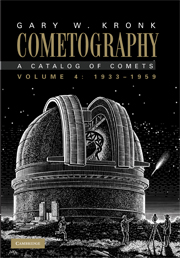Refine listing
Actions for selected content:
16950 results

The Martian Surface
- Composition, Mineralogy and Physical Properties
-
- Published online:
- 10 December 2009
- Print publication:
- 05 June 2008

Cometography
- A Catalog of Comets
-
- Published online:
- 10 December 2009
- Print publication:
- 11 December 2008
2 - Protoplanetary disk structure
-
- Book:
- Astrophysics of Planet Formation
- Published online:
- 05 June 2012
- Print publication:
- 10 December 2009, pp 34-64
-
- Chapter
- Export citation
Index
-
- Book:
- Astrophysics of Planet Formation
- Published online:
- 05 June 2012
- Print publication:
- 10 December 2009, pp 281-284
-
- Chapter
- Export citation
10 - Bayesian analysis of cosmic microwave background data
-
-
- Book:
- Bayesian Methods in Cosmology
- Published online:
- 11 April 2011
- Print publication:
- 10 December 2009, pp 229-244
-
- Chapter
- Export citation
4 - Planetesimal formation
-
- Book:
- Astrophysics of Planet Formation
- Published online:
- 05 June 2012
- Print publication:
- 10 December 2009, pp 109-145
-
- Chapter
- Export citation
List of contributors
-
- Book:
- Bayesian Methods in Cosmology
- Published online:
- 11 April 2011
- Print publication:
- 10 December 2009, pp ix-x
-
- Chapter
- Export citation
Preface
-
- Book:
- Bayesian Methods in Cosmology
- Published online:
- 11 April 2011
- Print publication:
- 10 December 2009, pp xi-xii
-
- Chapter
- Export citation
Contents
-
- Book:
- Bayesian Methods in Cosmology
- Published online:
- 11 April 2011
- Print publication:
- 10 December 2009, pp v-viii
-
- Chapter
- Export citation
Contents
-
- Book:
- Astrophysics of Planet Formation
- Published online:
- 05 June 2012
- Print publication:
- 10 December 2009, pp v-viii
-
- Chapter
- Export citation
3 - Parameter estimation using Monte Carlo sampling
-
-
- Book:
- Bayesian Methods in Cosmology
- Published online:
- 11 April 2011
- Print publication:
- 10 December 2009, pp 57-78
-
- Chapter
- Export citation
1 - Foundations and algorithms
-
-
- Book:
- Bayesian Methods in Cosmology
- Published online:
- 11 April 2011
- Print publication:
- 10 December 2009, pp 3-35
-
- Chapter
- Export citation
Part I - Methods
-
- Book:
- Bayesian Methods in Cosmology
- Published online:
- 11 April 2011
- Print publication:
- 10 December 2009, pp 1-2
-
- Chapter
- Export citation
3 - Protoplanetary disk evolution
-
- Book:
- Astrophysics of Planet Formation
- Published online:
- 05 June 2012
- Print publication:
- 10 December 2009, pp 65-108
-
- Chapter
- Export citation
Preface
-
- Book:
- Astrophysics of Planet Formation
- Published online:
- 05 June 2012
- Print publication:
- 10 December 2009, pp ix-x
-
- Chapter
- Export citation
13 - Photometric redshift estimation: methods and applications
-
-
- Book:
- Bayesian Methods in Cosmology
- Published online:
- 11 April 2011
- Print publication:
- 10 December 2009, pp 283-298
-
- Chapter
- Export citation
Appendix 2 - N-body methods
-
- Book:
- Astrophysics of Planet Formation
- Published online:
- 05 June 2012
- Print publication:
- 10 December 2009, pp 264-272
-
- Chapter
- Export citation
7 - Bayesian source extraction
-
-
- Book:
- Bayesian Methods in Cosmology
- Published online:
- 11 April 2011
- Print publication:
- 10 December 2009, pp 167-192
-
- Chapter
- Export citation
1 - Observations of planetary systems
-
- Book:
- Astrophysics of Planet Formation
- Published online:
- 05 June 2012
- Print publication:
- 10 December 2009, pp 1-33
-
- Chapter
- Export citation
12 - A Bayesian approach to galaxy evolution studies
-
-
- Book:
- Bayesian Methods in Cosmology
- Published online:
- 11 April 2011
- Print publication:
- 10 December 2009, pp 265-282
-
- Chapter
- Export citation
